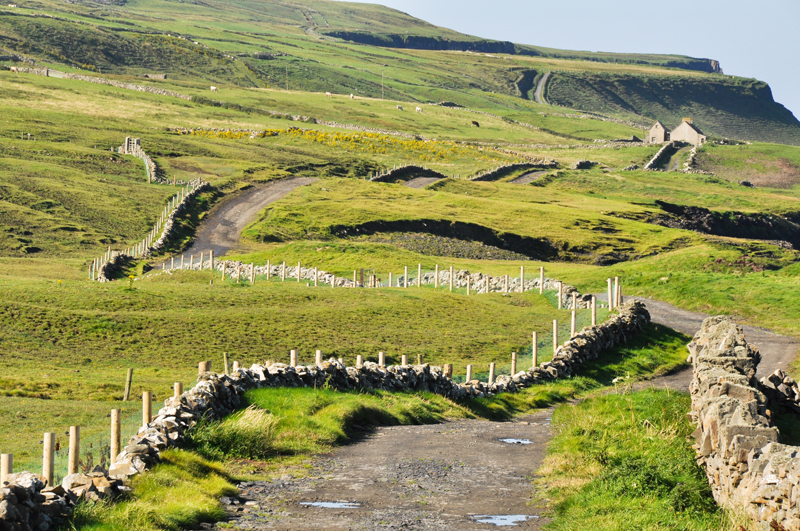“Dancing at Lugnasa” A Movie Review

Mix the sweet Donegal landscape, Meryl Streep, an author with a clue, and you have “Dancing at Lughnasa.” The first time I saw it, I could smell the peat fire from my grandmother’s stove. The second time I watched it, the sight of the chickens at the water tap brought tears to my eyes, and by the third time, I was ready to absorb the fascinating goings on in this rich and telling film.
Based on the Tony Award-winning play by Brian Friel, “Dancing...” gently describes the social strictures that have contributed in so many ways to the shocking revelations that have shaken that image of a purer, more innocent place, that impossibly untouched Ireland of the 30s, 40s, and on...until the tabloids got ahold of it in the past 10 or 15 years. The social demons of illegitimacy, pedophilia, drugs---God knows what--—in holy Ireland, oh how they have torn at the very roots of our stereotypes. These are the results of the corrupting influence of unquestioned authority and the daunting power of social stigma. This film, set in 1936, gives us a prodromal whiff of the future, not just in Ireland, (but please, not Ireland!) but across the globe.
The five Mundy sisters are buoyed by the respectability of having a brother a priest in the missions. Though one of the sisters is the unwed mother of a lively 8-year-old boy (and who welcomes the flighty father back time and again with open arms), the social balance is maintained by virtue of the eldest sister's position as a teacher in the village and the priestly brother. Well, that shaky house of cards is upset when the brother returns to Ireland in disgrace, half-mad and having "gone native" in Africa.
The village priest relieves teacher Kate of her position---no reason given---just as the brother's train pulls into the station. It doesn't take the sisters long to figure out that their brother is not well as he rambles on about the glories of life in the African village...and that's not the half of it.
It is the harvest time, the time of the festival of Lughnasa, and this bittersweet story plays out with all of its dark deeds: deception, betrayal, and defection, while the bonfire burns to Lugh, a pagan god of light.
Based on the Tony Award-winning play by Brian Friel, “Dancing...” gently describes the social strictures that have contributed in so many ways to the shocking revelations that have shaken that image of a purer, more innocent place, that impossibly untouched Ireland of the 30s, 40s, and on...until the tabloids got ahold of it in the past 10 or 15 years. The social demons of illegitimacy, pedophilia, drugs---God knows what--—in holy Ireland, oh how they have torn at the very roots of our stereotypes. These are the results of the corrupting influence of unquestioned authority and the daunting power of social stigma. This film, set in 1936, gives us a prodromal whiff of the future, not just in Ireland, (but please, not Ireland!) but across the globe.
The five Mundy sisters are buoyed by the respectability of having a brother a priest in the missions. Though one of the sisters is the unwed mother of a lively 8-year-old boy (and who welcomes the flighty father back time and again with open arms), the social balance is maintained by virtue of the eldest sister's position as a teacher in the village and the priestly brother. Well, that shaky house of cards is upset when the brother returns to Ireland in disgrace, half-mad and having "gone native" in Africa.
The village priest relieves teacher Kate of her position---no reason given---just as the brother's train pulls into the station. It doesn't take the sisters long to figure out that their brother is not well as he rambles on about the glories of life in the African village...and that's not the half of it.
It is the harvest time, the time of the festival of Lughnasa, and this bittersweet story plays out with all of its dark deeds: deception, betrayal, and defection, while the bonfire burns to Lugh, a pagan god of light.
You Should Also Read:
Ireland in the Movies
Irish Culture Newsletter
Boys and Girl from County Clare

Related Articles
Editor's Picks Articles
Top Ten Articles
Previous Features
Site Map
Content copyright © 2023 by Mary Ellen Sweeney. All rights reserved.
This content was written by Mary Ellen Sweeney. If you wish to use this content in any manner, you need written permission. Contact Bee Smith for details.


